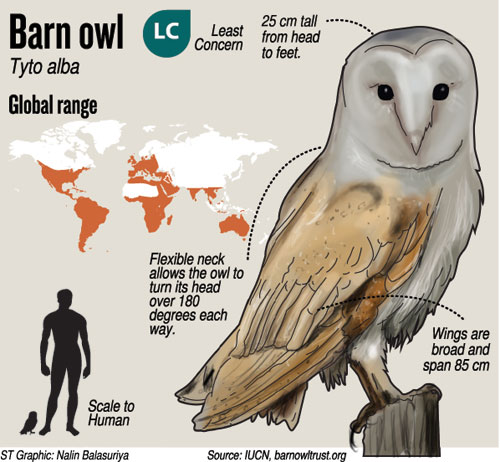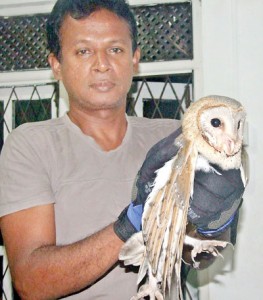News
Urban excitement over barn owls
 The barn owl is a rare bird in Sri Lanka categorized as ‘near threatened’ in the 2012 National Red List, but it wasn’t an April Fool’s joke that one was seen in Kirulapona on April 1.
The barn owl is a rare bird in Sri Lanka categorized as ‘near threatened’ in the 2012 National Red List, but it wasn’t an April Fool’s joke that one was seen in Kirulapona on April 1.
It had been attacked by crows and had fallen from the roof of a four-storey building, where it had taken refuge. It was handed over to wildlife expert Shantha Jayaweera who later released it. “Even through it had been attacked by crows, there were no external injuries.”
The barn owl (tyto alba) is a beautiful owl species with a whitish face, chest, and belly, and buffy upper parts. Its scientific name means, ‘white owl’.
Barn owls have adapted to living among humans. Granaries, warehouses, old buildings where its favorite prey, rats and mice, live attract the owl.
Mr Jayaweera thanks all those who ensured the owl’s safety. He stressed that owls do not represent a bad omen, but helps to remove harmful pests such as rats.
According to National Geographic, on average, a wild barn owl eats about four small mammals a night. That is 1,460 rats per year.
The barn owl is about 34 centimetres in length but its long wings make it looks bigger and elegant when flying. It mainly hunts by sound rather than by sight where its acute hearing can detect the slightest movement and sound of its prey.
The barn owl’s heart-shaped face collects sound in the same way as human ears and its hearing is the most sensitive of any creature tested, according to some literature. Barn owls are faithful lovers. A pair mates for life unless one gets killed. It breeds between February and March.
Mr Jayaweera, who is a senior member of the Young Zoologists Association, recalled that the National Zoological Gardens once received an injured barn owl from a public library few years ago. Responding to a post on social media, many shared sightings in Colombo and the suburbs.
“I have seen barn owls in Duplication Road, Fife Road, and near the Golf Club,” said Rex I De Silva.
Namal Kamalgoda had seen one in Town Hall, the National Museum and also in Dehiwala.
Others reported sightings in Pettah, Fort and surburbs such as Kottawa, Moratuwa and Ratmalana.

The rescued barn owl with Shantha Jayaweera
Environment lawyer, Jagath Gunawardane, who is also an expert on birds, stressed that unlike other rare birds of Sri Lanka, the barn owl is mostly found in old buildings in towns.
Another bird expert, Moditha Hiranya Kodikara Arachchi, shared an observation of a barn owl in Kandy inside the old Electricity Board building. “This barn owl was day-roosting on fans in the office without any trouble, until it was chased away because of droppings all over the office,” he said.
Experts fear that rat poison could harm these owls. According to the Barn Owl Trust, even a rodent eating a dose is not enough to kill it, and it may carry the poison in its liver for several months. So, before a poisoned rodent dies, the weakened rat may be caught by a barn owl, which then ingests the poison. Unfortunately, no research has been carried out on the effects of sub-lethal doses on wild barn owls.
“There could be a viable population of barn owls throughout Colombo and many other urban areas. It is an iconic bird in our urban settings,” said veteran ornithologist, Prof Sarath Kotagama.
He is inviting the public to share their barn owl sightings in Colombo and suburbs. Note the date and location by email:urbanbirds.srilanka@gmail.com or call 071- 8440144.

